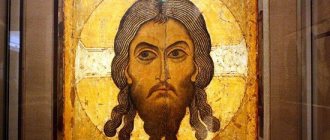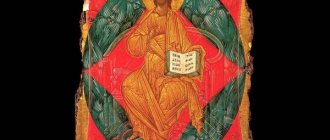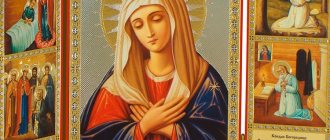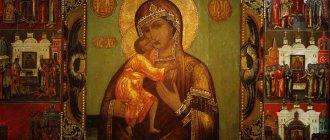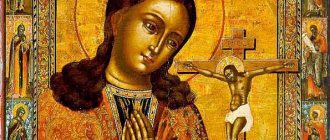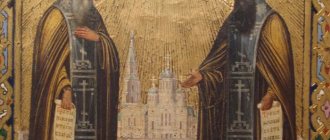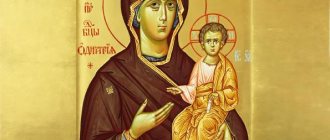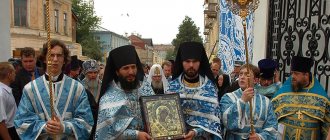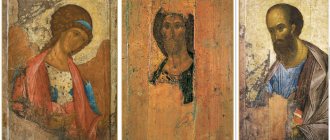The image of the “Sinai Savior on the Throne” is an icon that is the prototype of the oldest Orthodox icon - the Lord Pantocrator. The icon from the Temple of the Twelve Apostles was painted in the extremely rare and most complex technique of “encaustic”; the paints are applied to a wax primer using heated copper sticks - as if it were soldered inside. Thus, the picture becomes more vibrant and voluminous due to the relief. In addition, thanks to the encaustic technique, the colors never fade - they remain bright forever.
The icon “Lord Pantocrator from the Sinai Monastery” is the oldest shrine from the mid-6th century, which was destined to survive to this day. The original was created in Constantinople. Emperor Justinian donated it to the monastery of Santa Catarina, located on the Sinai Peninsula.
History of the icon “Savior on the Throne”
According to legend, the first icon of the Savior was not made by hands. There are several recollections that Jesus washed his face with water and then wiped it with an ubrus (handkerchief), and his bright face appeared on it. For many years, artists were forbidden to paint the Lord. And only in 787, at the Seventh Ecumenical Council, was the veneration of icons officially permitted.
The image of Jesus on a throne, wearing a crown, with an open Gospel on his knee appeared around the 9th century in the Byzantine Empire. Russian masters learned icon painting from the Byzantine ones, so that each work of church art complied with strictly established canons and carried a deep sacred meaning. And yet, Russian icons are distinguished by their brightness; they are saturated with vibrant and sonorous color. Only in the 12th century did “The Lord on the Throne” decorate churches in Russia.
Of all the images of the Lord Jesus Christ presented in the church, believers heartily honor the “Savior on the throne.” The Son of God is depicted in full growth, he sits majestically on the Divine throne, symbolizing royal power. For the Lord is the Pantocrator, the Heavenly King of all visible and invisible, of the entire Universe, his throne is higher than the earthly. The thoughts, deeds, good and sinful deeds of every person are open to Him.
The Son of God looks with love from the icon, but his gaze is incorruptible and stern, like that of a loving parent. The Supreme Priest of the church and the Almighty at the Last Judgment is impassive, but wise and fair. And he is the deliverer of immortal righteous souls at the end of all time. The halo around the Savior indicates the Divine glory and shining light.
The tunic of the King of Heaven on the icon is most often painted red, and the himation is blue. Shades of red symbolize martyrdom and royal dignity. Blue represents heavenly purity. The right hand raised up blesses all believers. Shadows are never reflected on icons, since the Celestials themselves are light.
Old Russian images of the Savior are found not only in Christian churches in Russia. Some of them belong to museums, for example:
- “The Savior on the Throne,” painted in Novgorod in the 15th century, is owned by the State Tretyakov Gallery.
- In the Assumption Cathedral of the Moscow Kremlin, the central part was occupied by the icon “The Savior on the Throne” by Kirill Ivanovich Ulanov. Nowadays it is under the jurisdiction of the State Tretyakov Gallery.
- The icon “The Savior on the Throne with the Present Mother of God and John the Baptist” belongs to the State Hermitage.
- The icon of the Rostov school “Christ Pantocrator on the Throne,” painted in the 16th century, is exhibited at the Andrei Rublev Central Museum of Ancient Russian Culture and Art in Moscow.
The meaning of the icon of Christ Pantocrator
Pantocrator, translated - the Almighty, who sacrificed himself for the remission of human sins and their forgiveness.
The Lord on the throne is an icon with the miraculous power of Christ Pantocrator - it protects families from illnesses and misfortunes, heals believers suffering even from incurable diseases. Orthodox believe that the face of Jesus Christ is capable of healing any mental or physical illness if the person praying has a pure and sincere heart and the kindest thoughts.
The oldest image of Christ, which has miraculous power, helps Orthodox believers and saves them from illnesses
The face of Jesus Christ can be found in any Christian church.
Priests even believe that the icon of the Savior on the throne should be in every home. The most popular and significant icons are located in the following houses of God:
- Church of St. Sophia, Nizhny Novgorod
- Church of the Savior on Spilled Blood, St. Petersburg
- Church of the Nativity of John the Baptist, Moscow.
But the first and oldest copy of the icon of the Lord Pantocrator from the Sinai monastery is considered to be the icon located in the monastery of St. Catherine in Egypt. It was she who served as the beginning of this style of iconography.
The clothing that covers the Saint is characteristic of the ancient Greeks - a loose shirt and a corner cape over it. The Bible - sacred scripture - is located in his left hand, and the symbol of blessing in the form of folded fingers is on his right.
The unity of the material and spiritual - this is precisely the meaning contained in three types of icons about the miraculous image of Jesus - a full-length image of the Savior, waist-length or sitting on the royal throne.
The holy image contains two faces of Jesus Christ at once - man and divinity. It is this feature that is visible in the reflection of the Saint: the light emanating from the right side of the face speaks of his Divine origin; on the left side we see a shadow, a downward gaze and the suffering humanity of Jesus.
Meaning in Orthodoxy
Jesus Christ is one of the main images in Christian iconography. Having accepted martyrdom, he did not lose his all-encompassing love for people. “The Savior on the Throne” is revered by the church, like other icons of the Pantocrator. It reminds of Heavenly Court, repentance and the importance of good deeds in people's lives.
The clergy advise all believers to have such an icon in their home. The image of the Lord is intended to remind followers of the Christian church of Divine love and the sacrifice that the Savior made for the salvation of all mankind.
Those who pray turn to the Lord in any, even very difficult situations:
- sincerely ask for forgiveness for sins committed in earthly life;
- thank Spas for his help and support;
- they pray for healing from fatal illnesses and mental wounds;
- ask for relief from mental and emotional disorders;
- they call on mercy for salvation from melancholy, despondency, anxiety, despair;
- They seek in prayers consolation, instructions on the true path, protection from deception, slander, and lies.
They pray not only for themselves, but also for their loved ones.
Icons of Christ the Savior
Icons of Christ, the incarnate God of the Word, occupy the main place both in an Orthodox church and in the home of a believer.
(On the right is the Savior).
The canonical image of God in human form was approved in the 9th century: “... Well-bodied... with knitted eyebrows, beautiful eyes, with a long nose, light brown hair, bowed, humble, beautiful in body color, with a dark beard, the color of wheat in appearance, maternal appearance, with long fingers, good-willed, sweet in speech, very meek, silent, patient...”
Early Christians depicted Christ in the form of a lamb, in the form of a fish, and in the form of a good shepherd carrying a sheep on his shoulders. These symbolic images were later banned.
Currently, there are two types of images of the Savior: 1) in the form of the Almighty and Judge - the King of Kings; 2) in the form in which He was among people and performed His ministry (including in the form of a baby or youth).
Sometimes you can also find images of Christ in the form of an angel.
But if the methods of depiction are so different, is it easy to recognize the Savior on the icons? Yes, it’s easy - thanks to one detail: the image of Christ has a cross-shaped halo.
What is a halo? This word is translated from Latin as “cloud”, “fog”, “halo”. The halo is a symbol of the uncreated Divine light, which the Savior showed to the disciples on Mount Tabor: “And He was transformed before them: and His face shone like the sun, and His clothes became white like light.”
The halo on the icons of the Savior also has an inscribed Cross. Inside it are three Greek letters representing God's words “I am who am” spoken to Moses.
Through the image of a halo, we confess two natures in Christ - Divine and human. The icon painter paints the Face of Christ in the likeness of a human face, and this confesses the dogma that Christ is “a perfect man in humanity.” The halo conveys that Christ is “perfect God according to the Divinity.”
On icons, Christ is often depicted with a book - it can be either closed or open. The open book contains a quotation from the Gospel. The book can also be depicted in the form of a scroll, but the symbolic interpretation is always the same - the saving teaching with which Christ came into the world.
Let us now look at the clothes of Christ. Usually the God-man is depicted dressed in a red chiton (clothing in the form of a shirt) and a blue himation (cloak, cape).
The red color symbolizes the earthly and human, blue - the heavenly and Divine natures of the Savior.
Usually on the right shoulder of the chiton you can also see a sewn-on dark stripe - this is a clave, in the ancient world - a sign of patrician dignity. On icons, he is a symbol of the purity and perfection of the earthly nature of the Savior and a sign of His special messianic role.
Icons of the Savior belong to six main iconographic types:
1. Savior Not Made by Hands 2. Savior Almighty (Pantocrator) 3. Savior on the Throne 4. Savior in Power 5. Savior Emmanuel
6. Spas Good Silence
Savior Not Made by Hands
The Savior Not Made by Hands has always been one of the most beloved images in Rus'. This is what was usually written on the banners of Russian troops. There are two types of images of the Image Not Made by Hands: the Savior on the ubrus and the Savior on the skull.
On icons of the “Savior on the Ubrus” type, the face of Christ is depicted on a cloth (towel), the upper ends of which are tied with knots. There is a border along the bottom edge.
The face of Jesus Christ is the face of a middle-aged man with delicate and spiritual features, with a beard divided in two, with long hair curly at the ends and parted in the middle.
The appearance of the icon “Savior on the Skull” is explained by the following legend. As already mentioned, the king of Edessa, Abgar, converted to Christianity. The miraculous image was glued to a “non-rotting board” and placed above the city gates.
Later, one of the kings of Edessa returned to paganism, and the image was walled up in a niche of the city wall, and after four centuries this place was completely forgotten. In 545, during the siege of the city by the Persians, the Bishop of Edessa was given a revelation about the location of the Icon Not Made by Hands.
When the brickwork was dismantled, the residents saw not only a perfectly preserved icon, but also the imprint of a face on a clay board (tile, skull) that covered the image not made by hands.
On the icons of “Savior on the Chrepiya” there is no image of a board, the background is smooth, and in some cases imitates the texture of tiles or simple masonry.
On Russian icons, the Savior Not Made by Hands is usually depicted calm, with open eyes. Catholics, on the contrary, paint the face of Christ as suffering, sometimes with his eyes closed, with a crown of thorns and traces of blood on his head.
Savior Almighty (Pantocrator)
Savior Pantocrator (Pantocrator) is another icon that can be seen in every Orthodox church.” (Usually the fresco or mosaic “Pantocrator” is located in the central domed part of the church).
In the icon, Christ appears before us dressed in a himation and tunic. The face of the Savior reflects the age of Christ during the period of preaching: He has straight, smooth hair hanging down to his shoulders, a small mustache and a short beard.
His right hand blesses, His left hand supports the closed or open Gospel.
Savior on the throne
Savior on the throne - this icon has many similarities with the previous image (book, blessing hand), but the figure of Christ is always depicted sitting on the throne in full growth. The throne is a symbol of the Universe, the entire visible and invisible world, and in addition - a sign of the royal glory of the Savior.
Days of celebration
The icon of the “Savior on the Throne” is in every church; it is honored on official days marked in the calendar of the Orthodox Church:
- August 14 - on this day the Dormition Fast begins, the church remembers the All-Merciful Savior and the Most Holy Theotokos;
- August 19 – celebration of the Transfiguration of the Lord God in front of his disciples on the top of Mount Tabor, the holiday is popularly called the Apple Savior;
- August 28 – honoring of the Most Holy Theotokos, Assumption of the Ever-Virgin Mary, end of Lent.
Prayer text
Prayer is the language in which people can communicate with the Celestials. He is pure and capable of elevating our consciousness, thoughts and feelings to unearthly heights. The main thing is to practice unceasing prayer and do it as sincerely as possible.
“Oh, great Savior! King of Heaven and Earth! Hear our prayers to You. Only before Your image do we kneel and ask for help. Don’t give up in difficult moments and stand up for our souls. We pray for our lives, for the souls of sinners.
We ask you tearfully, forgive us our sins and forgive us for them! Give us healing, deliver us from anger and resentment. Drive away our enemies and become a support in the troubles and difficulties of life.
You alone are our support, O mighty and all-powerful Jesus! May we glorify and praise Your great name! Let Your will be done! In the name of the Father, and the Son, and the Holy Spirit. Forever and ever. Amen".
